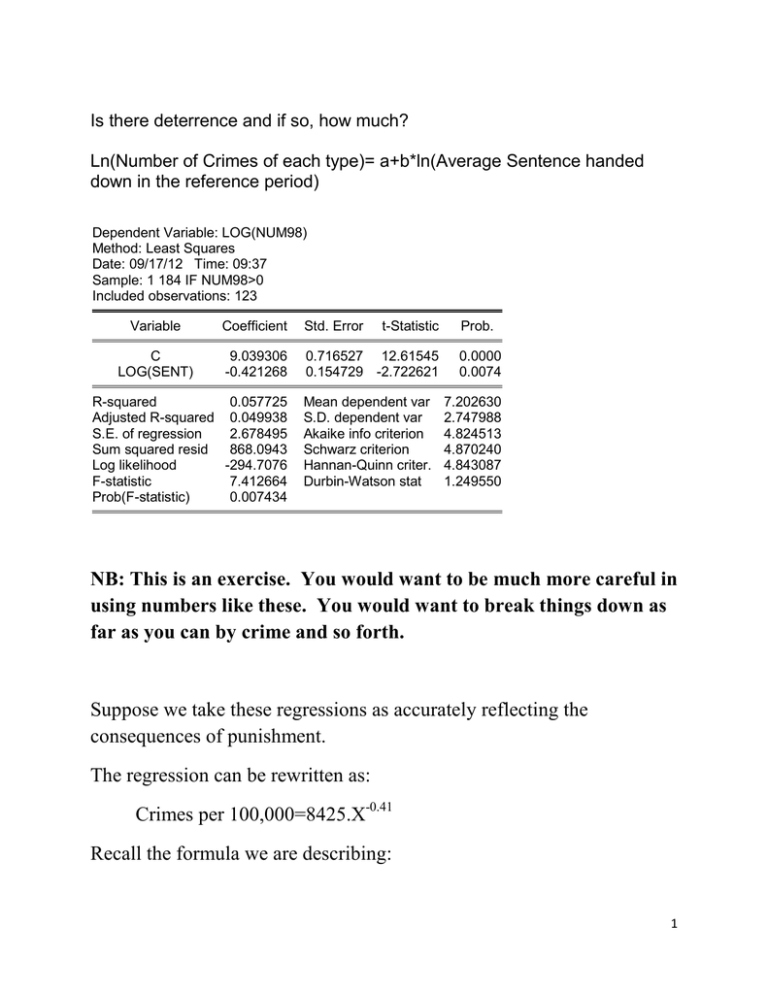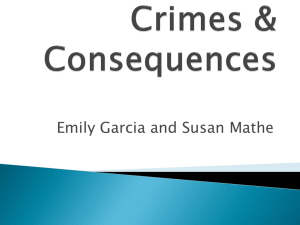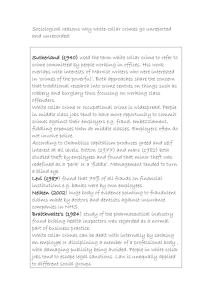Is there deterrence and if so, how much?
advertisement

Is there deterrence and if so, how much? Ln(Number of Crimes of each type)= a+b*ln(Average Sentence handed down in the reference period) Dependent Variable: LOG(NUM98) Method: Least Squares Date: 09/17/12 Time: 09:37 Sample: 1 184 IF NUM98>0 Included observations: 123 Variable Coefficient Std. Error C LOG(SENT) 9.039306 -0.421268 0.716527 12.61545 0.154729 -2.722621 R-squared 0.057725 Adjusted R-squared 0.049938 S.E. of regression 2.678495 Sum squared resid 868.0943 Log likelihood -294.7076 F-statistic 7.412664 Prob(F-statistic) 0.007434 t-Statistic Mean dependent var S.D. dependent var Akaike info criterion Schwarz criterion Hannan-Quinn criter. Durbin-Watson stat Prob. 0.0000 0.0074 7.202630 2.747988 4.824513 4.870240 4.843087 1.249550 NB: This is an exercise. You would want to be much more careful in using numbers like these. You would want to break things down as far as you can by crime and so forth. Suppose we take these regressions as accurately reflecting the consequences of punishment. The regression can be rewritten as: Crimes per 100,000=8425.X-0.41 Recall the formula we are describing: 1 𝑣 X*=� � ( 𝜋𝑏 −𝑒 1+𝑒 ) So what do we know? We have e: -0.40 We have b: the daily cost of keeping someone in a Canadian jail or prison is: b= $173 provincial and $346 federal ($63,000 and $126,290 annually) What about the probability of catching someone? Perhaps we should use the clearance rate for different crimes, or in this case the average crime: π= .40 Finally we need an estimate of the “value” of the crime: what did we find from our study of the cost of crime? V=$6,500 for common assault This yields: X=6,500/($173*0.40)*(.4/.6)=6500/(70)*2/3=93*(2/3)=approximately 60 days. What is the average sentence actually awarded? From the Crime Seriousness Index we find that the weight on the (173,000) assault level 1 is 23 days. Let’s refine our estimate a little bit: 2 The clearance rate (by charge) for assault is about 50%: 0.50 which doing the arithmetic implies an X*=50 days. Of course the sentence does not reflect the true cost of incarceration since for a crime like common assault the miscreant does not spend the entire sentence in jail. In all likelihood he will do about (1/6) of the sentence physically in the slammer! This certainly changes the calculation! Suppose we take the cost of jail as the average cost of (1/6) of time sentenced: or 6 times 50 = 300 days! (Notice that since it got cheaper, it is optimal to put him in longer.) Now suppose we turn the exercise around and ask, given the costs and the actual sentence, how much does the criminal justice system weight the damage done to the victim? That is, if the current sentence is optimal, what is the implicit weight on the harm done? V=πbX*(1+e)/(-e)=.5.$173.(23/6).(3/2)=$497! Thus even though the courts on the one hand award damages at the $6,500 level, the implied “value” of the crime is more like a tenth of that. Finally we might ask, what is the effect on the crime of assault if the numbers hold? That is we have now about 173,000 assaults when the sentence is 23 days or 23/6 days : call it 4 days. If we believe our estimates, and I remind you again that this is an exercise), then S=S0X-0.4. We can calculate S0: S=173,000 3 X=4 (days) so that 4-0.4 = 0.57 S0=S/X-0.4=(173,000/0.57)=300,000 So if we reduce the number of days in jail by 1, then we want to know the change in the number of crimes. The easiest way to do this is in “logs”: Ln S=lnS0-0.4lnX To find the change in the number of crimes: ΔlnS=(ΔS/S)=-0.4x(ΔX/X) or to isolate the actual change in the number of crimes, ΔS, ΔS=-0.4xSx(ΔX/X)=-.4x173,000x(-.25)=17,300 This gives us a sense of what the impact of a change in the punishment will be on a common crime. 4





